Palikari – Greek Military Youth Who Fought Against the Ottomans
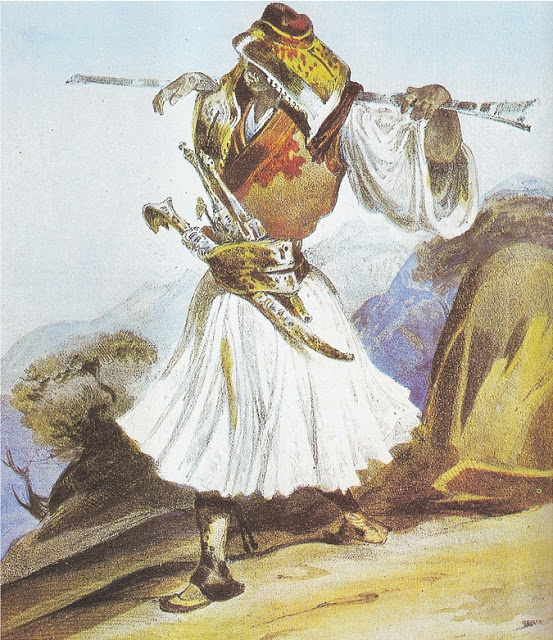
“Palikari” – Théodore Leblanc (1800? – 1837)
Here’s another Greek word, said to be “untranslatable”, however, the more I look into so-called “untranslatable” Greek words, I’m not sure there is such a thing.
Once you grasp the meaning, get a feel and the sense of a word and realize in what context it’s used, you can usually pin down an English equivalent (The same goes for any other language I would assume).
Here’s the word;
“Palikari”
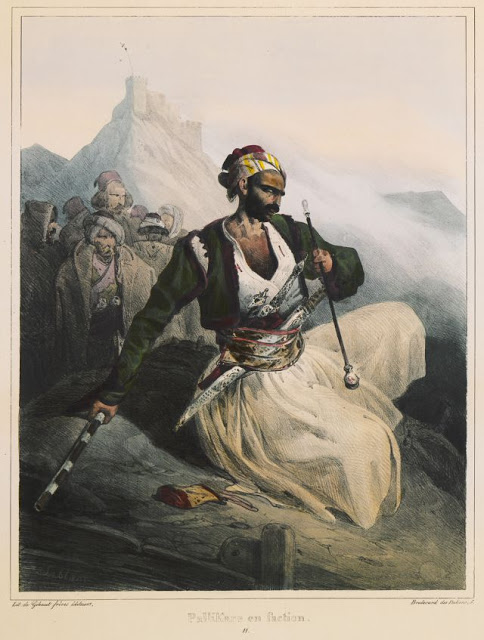
“Palikari, member of the irregular troops of the Peloponnese, with his clan”. Théodore Leblanc (1800? – 1837)
“Palikari”, is a Modern Greek word taken from the ancient Greek “pallax, pallex or pallix”, meaning, a lad, or, a youth, in his prime, just before adolescence and unmarried.
A “palikari’ or “palikar”, is a young, Greek military man who fought against the Ottomans (Turks) in the Greek Revolution – Greek War of Independence 1821.
A brave, valiant warrior, daring and courageous, one who never shies away from danger.
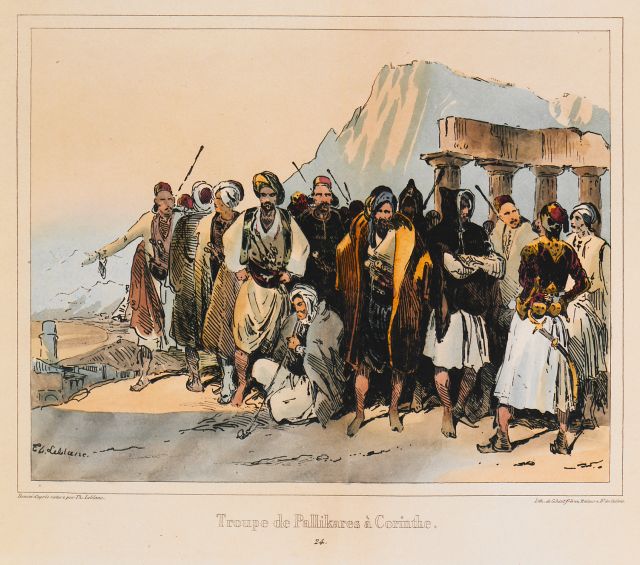
“Palikaria” and heads of irregular troops, at the temple of Apollo in Ancient Corinth. Théodore Leblanc (1800? – 1837)
Today, in Greece, when you hear someone using the word “palkari”, or calling someone a “palikari”, it’s invariably in an affectionate manner and more often than not, a compliment for a young boy or man, who has accomplished a strenuous or honourable task.
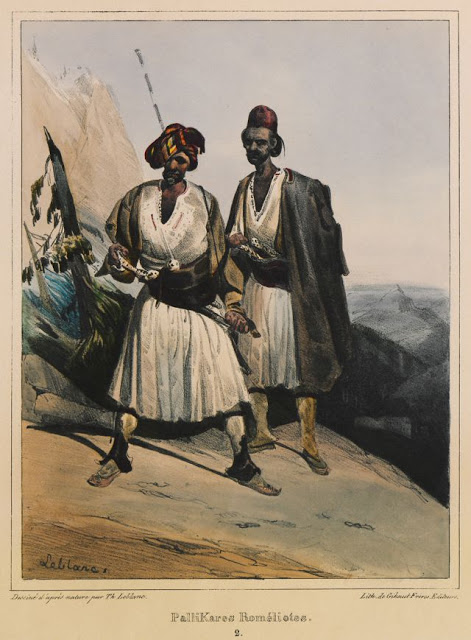
“Palikaria”, members of irregular troops of Roumeli, Greece.
Théodore Leblanc (1800? – 1837)
You might hear an elderly woman, thanking a “palikari” who helped her across the street, carried her shopping bags, or offered her his seat on a crowded bus.
A young man who stands up for the underdog and takes no flak from others is likely to be called a “palikari”.
Mothers frequently call their sons (regardless of age!), “palikari mou”- my warrior.
To understand the word “palikari”, in a deeper sense, let’s go back to The Greek Revolution of 1821.
The Greek Revolution of 1821
Greece was under Ottoman rule and the Ottomans, in order to keep the Greeks under control in inaccessible, mountainous regions often inhabited by “Klephts”, (Thief or brigand, warlike mountain-folk) created the “Armatolikia”.
..jpg)
Water-colour painting of an armatolos by Carl Haag (1820–1915).
“Armatolikia” were regions defended by “Armatoloi”(someone who deals with arms), who were Christian Greek irregular soldiers, commissioned by the Ottomans to enforce the Sultan’s authority.
Every “Armatoliki” had its captain (kapetanio), who had his rank-and-file soldiers, who were known as “palikaria”.
The “palikaria” trained with their weapons, mainly the “Kariofili”, on a daily basis and were well-known for their marksmanship.
In Italy there was a workshop producing muskets, with the name Carlo e figli. Greeks call it Kariofili and it was used by “Palikaria” against the Ottomans.
“Palikaria” were experienced in the art of ambush and were capable of going for long stretches of time, with neither food nor water.
With the outbreak of the Greek War of Independence, a large number of “Armatoloi” abandoned any allegiance to the Ottomans and formed Greek land forces.
These forces; the “Palikaria” were the only real threat to the Ottomans.

“Palikaria” fighting the Greek War of Independence.
Four of the most famous “Armatoloi”, or “Palikaria”, initially employed by Ali Pasha (Ottomans), who rebelled and fought for Greece in the Revolution are: Markos Botsaris, Georgios Karaiskakis, Odysseas Androutsos and Athanasios Diakos.
Markos Botsaris
Markos Botsaris Jean-Léon Gérôme, 1874.
Markos Botsaris, 1788-1823, was a Greek general and hero of the Greek War of Independence and captain of the Souliotes.
Botsaris is among the most revered national heroes in Greece.
Botsaris was born into one of the leading clans of the Souliotes, in the region of Souli, Epirus, the second son of captain Kitsos Botsaris, who was murdered in Arta in 1809, under the orders of Ali Pasha.
The Botsaris clan came from the village of Dragani (today Ambelia), near Paramythia.
Georgios Karaiskaki
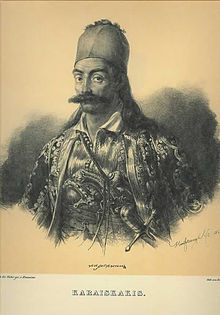
Georgios Karaiskakis lithography by Karl Krazeisen
Born Georgios Karaiskos, he was a famous Greek klepht, armatolos, military commander and a hero of the Greek War of Independence, born in a monastery near the village of Skoulikaria, close to Arta.
His father, Dimitris Iskos or Karaiskos, was the armatolos of the Valtos district, his mother Zoe Dimiski, from Arta, Greece, was the cousin of Gogos Bakolas, captain of the armatoliki of Radovitsi, a village in Montenegro.
Karaiskakis was of Sarakatsani descent; ethnic Greeks, traditionally transient shepherds, native to Greece and in smaller numbers, also found in Bulgaria, southern Albania and North Macedonia.
Odysseas Androutsos
 Painting by Dionysios Tsokos. National Historical Museum, Athens..jpg)
1825) Painting by Dionysios Tsokos. National Historical Museum, Athens.
Odysseas Androutsos,1788–1825, was a hero of the Greek War of Independence, born in Ithaca, his family was from the village of Livanates in the Phthiotis prefecture.
His father was Andreas Androutsos, a klepht, his mother was from Preveza.
After losing his father, Androutsos joined the Turkish army of Ali Pasha and became an officer, in 1818 he joined the Friendly Society – the Filiki Eteria which was planning the liberation of Greece from the Ottoman Empire.
Athanasios Diakos
by Dionysios Tsokos (1861). National Historical Museum, Athens.
Athanasios Diakos 1788 – 1821 was a Greek military commander during the Greek War of Independence, considered a national hero in Greece, born Athanasios Nikolaos Massavetas, in Phocis, in the village of Ano Mousounitsa, or according to other sources, in nearby Artotina.
The grandson of a local outlaw, or klepht, Athanasios Diakos, was drawn to religion from an early age and was sent away by his parents to the Monastery of St. John the Baptist, near Artotina, for his education.
He became a monk at the age of seventeen and due to his devotion to his faith and good temperament was ordained a Greek Orthodox deacon not long afterwards.
Is “Palikari’ an untranslatable Greek word?
I think not.
These then, were the “Palikaria” (Plural of palikari) of the Greek Revolution of 1821, Simple, but strong young men, inhabiting the mountainous and rural areas of Greece, fighting for a cause, fighting for the persecuted.
Men, of what we would call today, “The Working Class”
I think I would be correct then in translating the Greek word “Palikari” as something akin to; resistance fighters, guerrilla soldiers, partisans or in one word, a rebel or a warrior.

-e1676973466480.jpg?resize=400%2C245&ssl=1)

